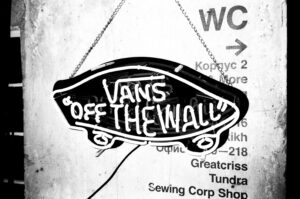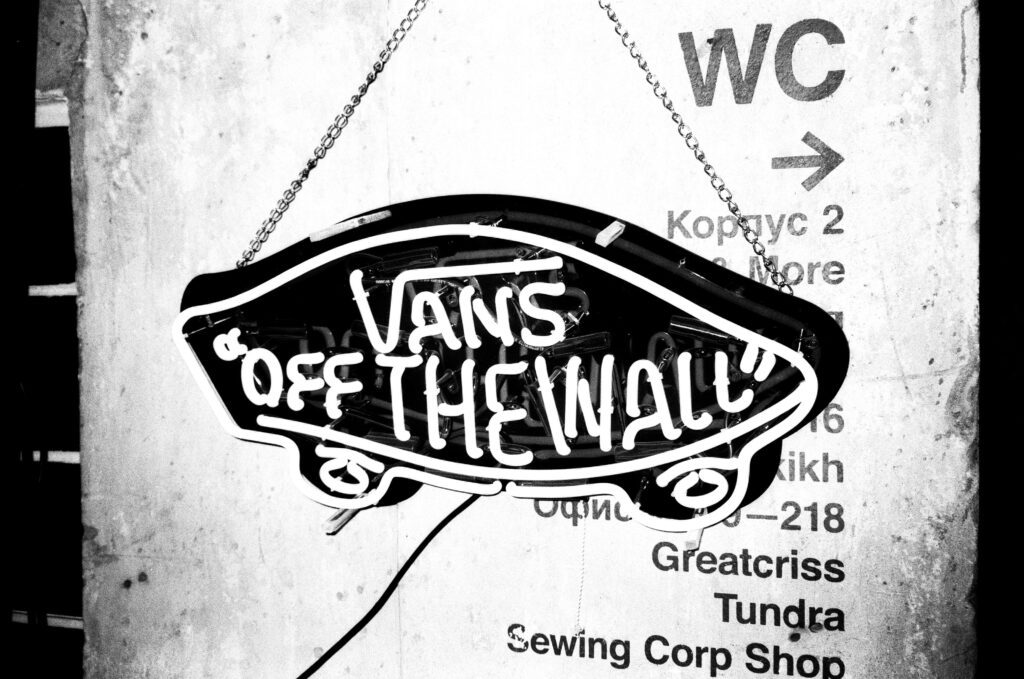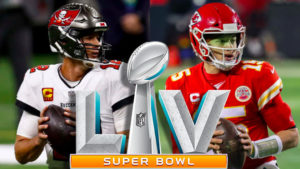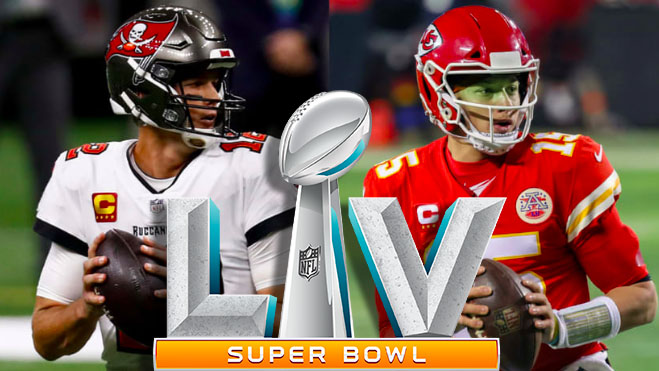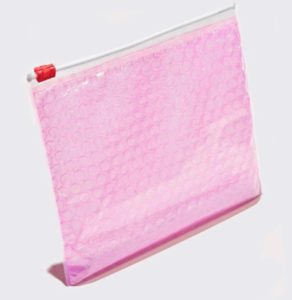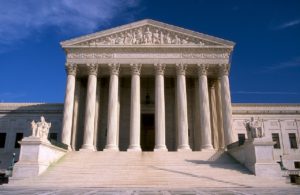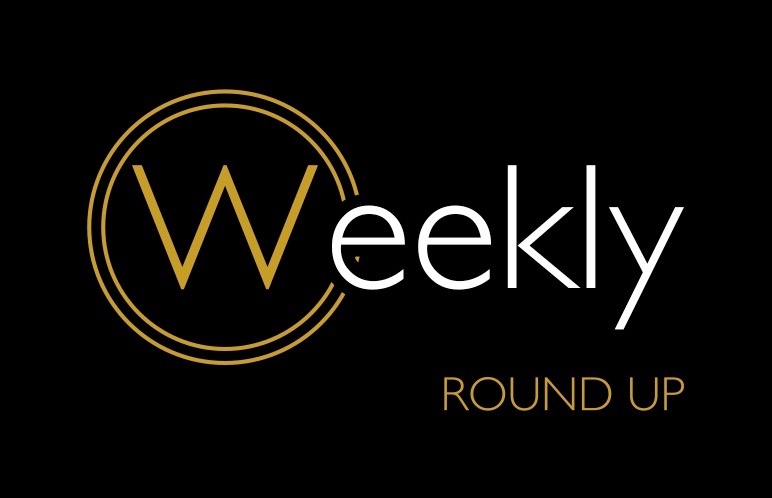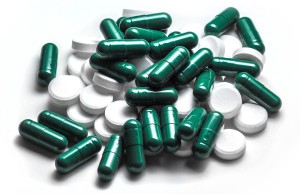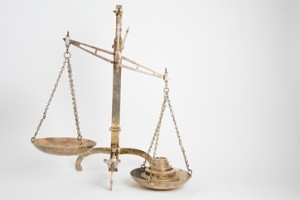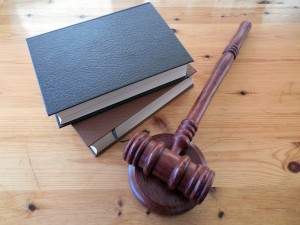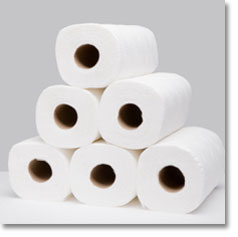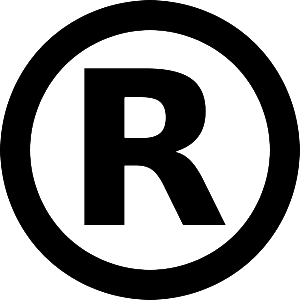By Mary-Kathryn Hawes
Glossier, a millennial favorite beauty brand, is attempting to trademark its signature “millennial pink” used on the pink bubble-wrap pouches that their products arrive in. Emily Weiss (who millennials may recall had a brief stint on the popular MTV series “The Hills” as the Teen Vogue New York intern[1]) parlayed her successful beauty blog into Glossier, an independent beauty company valued at over $1.2 billion.[2] Launched in 2014, Glossier is somewhat unique for not only surpassing the ever-popular Kylie Cosmetics in value,[3] but Glossier also raised nearly $200 million in venture capital investments to date.[4]
With this meteoric rise, Glossier has sought to protect its intellectual property rights, receiving trademarks for their crowd favorite products Boy Brow and Balm Dotcom in 2017[5] and 2019,[6] respectively. On 09 May 2019,[7] Glossier filed a § 1(a) application to register their signature pink zip-top, bubble-wrap pouches as a trademark.[8] Specifically, Glossier described the mark as consisting “of the color pink and a translucent circle patterns displayed on the bag are claimed as a feature of the mark which is displayed on bags.”[9]
Trademark
Primer
Trademarks
include “any word, name, symbol, or device, or any combination thereof . . . to
identify and distinguish his or her goods.”[10] Thus, trademarks primarily serve as source
identifiers.[11]
While the traditional trademark may be a word or design mark, the Lanham Act
also extends trademark protection to trade dress, which can include features
such as size, shape, and color, among others.[12]
Marks that are inherently distinctive, whose “intrinsic nature serves to
identify a particular source of a product”, are eligible for registration on
the Principal Register.[13]
Conversely,
other marks, such as those that are merely descriptive[14]
or merely a surname[15],
are eligible for registration on the Principal Register once the applicant
demonstrates that the mark has become “distinctive of the applicant’s goods in
commerce.”[16]
For example, the mark “ORANGE” used for an orange stand is merely descriptive
because it describes a characteristic of the good.[17]
The mark does not immediately signify source to a consumer. However, over time,
such descriptive marks can come to signify source[18]
and thus, the mark can become eligible for registration on the Principal
Register with a showing of acquired distinctiveness, or secondary meaning. Five
years of continuous use in commerce provides prima facie evidence that the mark
has acquired distinctiveness.[19]
As
noted in the seminal case of Qualitex v. Jacobson, marks that consist of
a color cannot be inherently distinctive and require proof of secondary
meaning.[20]
While color doesn’t immediately signify source to consumers, over time, colors
can become source identifiers. Thus, colors are eligible for trademark
registration if the color is not functional[21] and
is shown to have secondary meaning in connection with the applicant’s goods or
services.[22]
After an
applicant files for trademark registration, the examining attorney at the
United States Patent and Trademark Office (PTO) examines the mark and issues a
response to the applicant within 6–12 months. The examining attorney can either
permit the mark to be registered on the Principal Register or notify the
applicant in writing of the statutory grounds for rejection.[23] Generally,
the applicant has six months to respond to this initial office action.[24]
After reviewing the applicant’s response, the examining attorney will either
publish the mark for registration[25]
or issue a second, final office action rejecting the mark.[26]
Glossier’s
Trademark Battle
In the
initial office action issued on 24 July 2019, the United States Patent and
Trademark Office refused registration of the mark because it appeared to be a
functional design for the packaging.[27]
While Glossier claimed the “translucent circle patterns” as a feature of the
mark, the examining attorney found in the examination of the submitted sample
that the circles were air bubble cushioning.[28]
Because the bubble wrap served a protective feature for the goods stored
within, the examining attorney found that “a central feature of applicant’s
bags has a specific utilitarian advantage.”[29]
Further,
the examining attorney attached an Amazon webpage for bubble wrap mailing
envelopes that are used for protecting items as a similar item to Glossier’s zip-top
pouches.[30]
Finding that the mark was not inherently
distinctive, the examining attorney found that the mark was not eligible for
registration on the Principal Register without proof of acquired
distinctiveness.[31]
On 23
January 2020, Glossier filed their response to the initial office action, arguing
that the proposed mark “consists of the claimed color pink as applied to a very
particular type and configuration of product packaging . . . the air bubbles
and the packaging itself are not claimed as features of the mark.”[32] Thus,
Glossier is seeking to just trademark the color millennial pink on the pouches
and not the air bubbles.[33]
While this argument likely gets rid of the functionality bar to their
registration, Glossier must still prove that millennial pink has gained
secondary meaning.[34]
Given
that Glossier claims a first use date of 06 October 2014, Glossier first made a
§ 2(f) claim in their response that they have acquired distinctiveness.[35] Further,
Glossier argues that the color pink is not functional, given that there is no
distinct advantage to making the packaging pink and there are other colors
available for competitors to use on their packaging.[36]
Thus, Glossier argues that the only remaining factor is whether the color pink,
as a mark, has acquired distinctiveness.[37]
Whether
a mark has acquired distinctiveness is a fact-specific inquiry. The Trademark
Manual of Examining Procedure provides a nonexclusive list of different types
of evidence that used in the past to prove secondary meaning:
- Long
Use of the Mark in Commerce[38]
- Advertising
Expenditures[39]
- Affidavits
or Declarations Asserting Recognition of Mark as Source Indicator[40]
- Survey
Evidence, Market Research, and Consumer Reaction Studies[41]
- Parodies
and Copies[42]
“No
single evidentiary factor is determinative.”[43]
In its response, Glossier used these factors to argue that the pink pouch has
acquired distinctiveness.
First,
Glossier points out that the mark has been used continuously since 2014 and in
2018, sales under the mark generated more than $100 million in revenue.[44]
Glossier also attached 98 sworn declarations from Glossier customers who
attested that they “immediately recognize the color pink as applied to the
Glossier Pink Pouch indicates that the cosmetics and skincare products
originate from Glossier and not from any other source.”[45]
Additionally,
Glossier attached exhibits demonstrating their advertising and marketing of the
pink pouch.[46]
Interestingly, as evidence of the applicant’s success in educating the public
to associate the proposed mark with a single source, Glossier pointed to third
party social media posts.[47]
Consumers post and tag images of their Glossier pink pouches, which Glossier
argues simultaneously demonstrates that consumers already associate the pink
pouch with Glossier and reinforces the connection between Glossier and the pink
pouch.[48]
Glossier
also provided evidence of unsolicited media coverage, linking various articles
touting the “most notorious” and “popular” pink pouch.[49]
Given that the existence of parodies and copies of the proposed mark can be
evidence of secondary meaning, Glossier pointed to Jimmy Choo’s 2016 pink
handbag that resembled pink bubble wrap.[50]
Glossier noted that many fashion insiders believed that Jimmy Choo’s handbag
was intended to mimic Glossier’s pink pouch.[51]
Ultimately,
Glossier asserted that the “abundance of evidence demonstrates that the color
pink, as applied to bags featuring lining of translucent circular air bubbles
and a zipper closure, has acquired source-indicating significance in the minds
of the relevant consumers. When consumers see the Pink Pouch, they immediately
recognize it as emanating from Glossier.”[52]
Thus, Glossier contends that their mark is eligible for registration on the
Principal Register with a claim of secondary meaning.[53]
What
Happens Next:
After
the examining attorney reviews Glossier’s response, the attorney will either
issue a second, likely non-final rejection or publish the mark for opposition
if Glossier successfully argues that millennial pink serves as a source
identifier.
Ultimately,
it’s up to the PTO to determine whether millennial pink serves as a source
identifier, and thus, is eligible for trademark registration. Regardless of the
outcome, there is at least one important takeaway from Glossier’s quest to
trademark the millennial pink as used in conjunction with their pink pouch.
Glossier’s
proposed trademark underscores the importance of social media in analyzing
secondary meaning in this increasingly digital age. Glossier explicitly used
evidence of third-party social media posts to demonstrate their advertising and
marketing. Unsurprisingly, the pouch is “Instagrammable” and these
micro-impressions created by the social media posts all contribute to the pink
pouch becoming a source identifier in the minds of consumers. As we move into
an increasingly digital age, the PTO will likely continue to see these creative
arguments.
[1] Jonah Waterhouse, Fashion Stars You Completely
Forgot Cameoed in ‘The Hills,’ Harper’s
Bazaar (Jan. 10, 2018, 11:13 PM), https://www.harpersbazaar.com.au/culture/fashion-star-cameos-the-hills-15487.
[2] Bridget March, Glossier is Now Valued at More Than
$1.2 Billion, Harper’s Bazaar
(Mar. 20, 2019), https://www.harpersbazaar.com/uk/beauty/make-up-nails/a26881951/glossier-valuation-unicorn/.
[3] #2 Kylie Jenner, Forbes, https://www.forbes.com/profile/kylie-jenner/#209490cd55b5 (last updated Feb. 17,
2020) (noting that Kylie Cosmetics is currently worth at least $900 million).
[4] Kate Clark, Glossier Triples Valuation, Enters
Unicorn Club With $100M Round, TechCrunch
(Mar. 19, 2019, 1:17 PM), https://techcrunch.com/2019/03/19/glossier-triples-valuation-enters-unicorn-club-with-100m-round/.
[5] BOY BROW, Registration No. 5,170,111.
[6] BALM DOTCOM, Registration No. 5,646,307.
[7]
Unfortunately, 09 May 2019 was a Thursday, not a Wednesday.
[8] U.S. Trademark Application Serial No. 88/422,357 (filed May 09, 2019).
[9] Id.
[10]
15 U.S.C. § 1127 (2018).
[11]
Id. See also New Kids on the Block v. News Am. Publ’g, Inc., 971
F.2d 302, 305 n.2 (9th Cir. 1992) (“In economic terms, trademarks reduce
consumer search costs by informing people that trademarked products come from
the same source.”).
[12]
§ 1127. See also Sally Beauty Co. v. Beautyco, Inc., 304 F.3d 964 , 977
(10th Cir. 2002) (citing Two Pesos, Inc. v. Taco Cabana, Inc., 505 U.S. 763,
764 n.1 (1992)).
[13]
Two Pesos, 505 U.S. at 768.
[14]
15 U.S.C. § 1052(e)(1) (2018).
[15]
15 U.S.C. § 1052(e)(4) (2018).
[16]
15 U.S.C. § 1052(f) (2018).
[17]
Abercrombie & Fitch Co. v. Hunting World, Inc., 537 F.2d 4, 9 (2d Cir.
1976).
[18]
See,e.g., Qualitex Co. v. Jacobson Prods. Co., 514 U.S. 159, 163 (1995).
[19] §
1052(f).
[20]
Qualitex, 514 U.S. at 163.
[21]
The functionality doctrine forbids use of a product’s feature as a trademark
when doing so will put a competitor at a significant, non-reputational
disadvantage because the feature is either essential to the use or purpose of
the article or it affects the cost or quality of the good or service. Id.
at 169.
[22]
TMEP § 1202.05 (Oct. 2018).
[23]
TMEP § 705 (Oct. 2018).
[24]
TMEP § 705.08 (Oct. 2018).
[25]
TMEP § 713 (Oct. 2018).
[26]
TMEP § 714.03 (Oct. 2018). Notably, the second office action is typically a
final office action. However, if an applicant raises a claim of acquired
distinctiveness in their response to the initial office action, then the
applicant has generally presented a new issue. TMEP § 714.05(a)(i) (Oct. 2018).
Thus, if the examining attorney finds that the response still does not overcome
the grounds of refusal, then the examining attorney should issue another
non-final office action. Thus, it is possible for applicants to receive more
than two office actions. TMEP § 715.03(b) (Oct. 2018).
[27] Office Action Outgoing, United States Patent &
Trademark Office (July 24, 2019), https://tsdr.uspto.gov/documentviewer?caseId=sn88422357&docId=OOA20190724164311#docIndex=5&page=1.
[28]
Id.
[29]
Id.
[30]
Id.
[31]
Id.
[32] Response to Office Action, United States Patent &
Trademark Office (Jan. 23, 2020), https://tsdr.uspto.gov/documentviewer?caseId=sn88422357&docId=OOA20190724164311#docIndex=1&page=1.
[33] Id.
[34] Id.
[35] Id.
[36] Id.
[37] Id.
[38]
TMEP § 1212.06(a) (Oct. 2018).
[39] TMEP § 1212.06(b) (Oct. 2018) (noting that while large scale
advertising expenditures are significant to indicate use of the mark, “[t]he
ultimate test in determining whether a designation has acquired distinctiveness
is applicant’s success, rather than its efforts, in educating the public to
associate the proposed mark with a single source”).
[40]
TMEP § 1212.06(c) (Oct. 2018) (“[S]urvey[s]
must show that the consuming public views the proposed mark as an indication of
the source.”).
[41]
TMEP § 1212.06(d) (Oct. 2018).
[42]
TMEP § 1212.06(e)(vi) (Oct. 2018).
[43]
TMEP § 1212.06 (Oct. 2018).
[44] Response to Office Action, United States Patent &
Trademark Office (Jan. 23, 2020), https://tsdr.uspto.gov/documentviewer?caseId=sn88422357&docId=OOA20190724164311#docIndex=1&page=1.
[45] Id.
[46] Id.
[47] Id.
[48] Id.
[49] Id.
[50] Id.
[51] Id.
[52] Id.
[53] Id.

